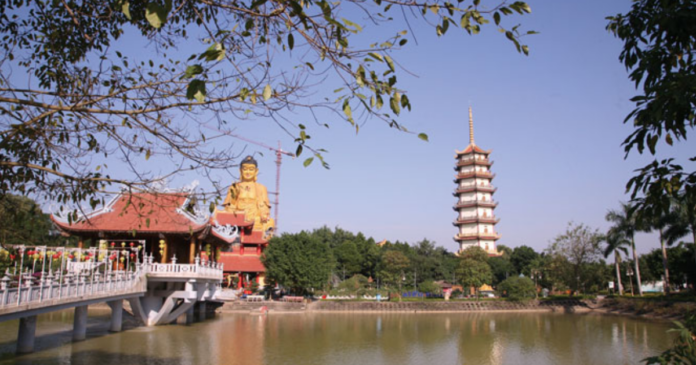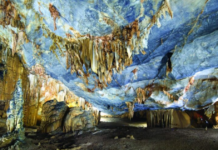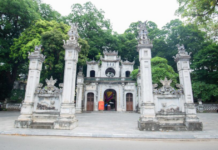Khai Nguyen Pagoda is one of the prominent temples in Vietnam. It attracts visitors not only with its unique architecture but also with its peaceful and spiritually vibrant atmosphere. In this article, we will explore the history, architecture, and distinctive spiritual activities at Khai Nguyen Pagoda. This will give you a comprehensive view of the temple and the reasons why it has become a must-visit destination for travel enthusiasts.
1. Khai Nguyen Pagoda: Location and How to Get There
1.1. Location of Khai Nguyen Pagoda
Khai Nguyen Pagoda, formerly known as Co Lieu Tu or commonly called Teo Pagoda, is a well-known temple located in Khoang Sau Village, Son Dong Commune, Son Tay Town, Hanoi. About 44 kilometers west of Hanoi’s city center, the pagoda attracts visitors not only for its sacredness but also for its serene and relaxing environment amidst nature. The pagoda is open to visitors daily from 7:00 AM to 8:00 PM, including during holidays and festivals. Khai Nguyen Pagoda is always ready to welcome those who are passionate about exploring culture and spirituality. It is not just a place of worship but also a rich cultural and spiritual treasure of the Vietnamese people.

1.2. How to Get to Khai Nguyen Pagoda
Khai Nguyen Pagoda is located about 44 kilometers from downtown Hanoi, making it easy to access. There are several transportation options available, but the two most popular routes are via National Road 32 or the Lang-Hoa Lac Expressway. The wide and convenient roads allow you to enjoy the beautiful scenery while also visiting other famous landmarks in Son Tay and Ba Vi.
If you choose to travel by motorbike, car, or taxi, it will take you about an hour from the center of Hanoi. For those who want to save on costs, Bus No. 74 is an excellent option. The bus departs from My Dinh Bus Station, and the ticket price is just 9,000 VND per trip. Don’t forget to check the bus stop to get off at the right place!
2. The Mystical History of Khai Nguyen Pagoda, Son Tay
Khai Nguyen Pagoda, with a history spanning thousands of years, has undergone numerous ups and downs, particularly during the war periods. It was originally constructed in the 11th century under the Ly Dynasty and once served as an important spiritual symbol. During the Nguyen Dynasty, the pagoda was relocated to the area of Den Trung.
However, the two wars against France and the United States left severe destruction, causing significant damage to the temple’s architecture. In 1997, Khai Nguyen Pagoda was first restored. In 2008, when Venerable Thich Dao Hanh became the abbot, he restored the temple to its original location and carried out a second renovation.
Despite the multiple renovations, the pagoda has retained its ancient charm and historical value. Before it was named Khai Nguyen, the temple was known as Co Lieu Tu. In the early 16th century, it was constructed under the Ly Dynasty but suffered near-total destruction.
In 2003, with the approval of the local authorities and the trust of the people, Venerable Thich Dao Hanh proposed relocating the pagoda back to its original site, along with plans for expansion and restoration. The main area of the temple today is built on the old foundation, recreating its original architecture and preserving its unique beauty and valuable historical significance.
3. Exploring the Beauty of Khai Nguyen Pagoda
3.1. Architecture of Khai Nguyen Pagoda: A Fusion of Modern and Ancient
With its grand scale and diverse structures, Khai Nguyen Pagoda has become an ideal destination for both Buddhists and visitors interested in architecture and culture. One of the prominent features of the pagoda is its architectural style, which blends modern and classic elements, creating a unique harmony. The main worship halls are arranged in the “front Buddha, rear Ancestors” style, alongside structures such as the Sang Duong (Monk’s Hall), Bao An Tower, Bell Tower, and Drum Tower, offering a rich experience for visitors.
Inside the pagoda, many valuable cultural and historical artifacts await exploration. Two stone steles from 1759 and a bronze bell cast in 1870 are treasured legacies that represent the profound cultural significance of the pagoda. The system of Buddha statues, from large to small, creates a sacred and peaceful atmosphere, attracting many visitors.

In front of the pagoda, a rectangular pond with emerald green water all year round highlights the serene beauty of the temple grounds. In the middle of the pond stands a pavilion resembling the One-Pillar Pagoda, where the statue of Kshitigarbha Bodhisattva is enshrined, and a valuable Kshitigarbha Sutra is kept, drawing the attention of many Buddhists. Khai Nguyen Pagoda is truly an unmissable destination for those who appreciate the blend of history, culture, and nature.
3.2. The Great Statue of Amitabha Buddha: A Grand Symbol of Southeast Asia
A standout feature of Khai Nguyen Pagoda is the largest statue of Amitabha Buddha in Southeast Asia. This statue is considered one of the greatest architectural works in the world. Standing at a height of 72 meters, with a base covering an area of 1,200 square meters, the statue is a masterpiece that perfectly blends architecture and sculpture art.

Amitabha Buddha, the Lord of the Western Pure Land, represents the highest ideals, helping people overcome the troubles of life. The statue carries profound meaning, wishing for peace, health, and blessings for all. The statue depicts the majestic image of Amitabha Buddha in the lotus posture, with a face exuding compassion and wisdom. In his left hand, he holds a blossoming pink lotus, while his right hand forms the gesture of Teaching (Dharma Mudra). The Dharma Wheel is carved on the palm, reflecting the deep philosophies of Buddhism. The base of the statue is designed as a giant lotus with three layers of 56 petals. Inside, the statue has 13 levels: 12 levels are dedicated to visitors worshipping Bodhisattvas, while a subterranean level is constructed to simulate the Six Realms of Samsara. The underground area not only serves as a worship space but also features a model of the 18 levels of Hell, helping Buddhists understand the law of cause and effect and the practice of virtue.
3.3. The Collection of Valuable Relics and Buddha Statues
Khai Nguyen Pagoda is not only a spiritual destination but also a treasure trove of rich culture and history. A highlight within the temple grounds is its vast collection of Buddha statues, with 1,975 statues of varying sizes displayed in the Tam Bao Hall, creating a solemn and warm worship space. These statues are crafted from precious materials such as bronze and jade, enhancing their mystical beauty and attracting numerous visitors and worshippers.

In addition to its artistic beauty, the pagoda also houses many valuable historical artifacts. One of the prominent treasures is the bronze bell cast in 1870 during the Tu Duc reign, along with two stone steles dating from the 19th year of the Canh Hung era and the 14th year of the Gia Long era. These relics not only hold deep religious value but also serve as invaluable resources for research on Vietnamese culture and history.
4.Interesting Activities at Khai Nguyen Pagoda
Khai Nguyen Pagoda is an ideal place to seek peace and tranquility amidst the hustle and bustle of daily life. Throughout the year, the pagoda organizes many meaningful activities to attract Buddhist followers, with the summer meditation retreat being a notable example. This event not only provides an opportunity for practitioners to interact and meet friends but also serves as a space for them to engage in spiritual activities aligned with ethical standards.

The summer meditation retreat typically takes place in June and July and always receives significant attention from Buddhists. In addition, every weekend, the pagoda hosts Dharma talks where families can gather to enjoy vegetarian meals and participate in useful labor activities for the temple. These activities not only help Buddhists accumulate merit but also create a warm, peaceful, and joyful atmosphere in daily life.
5. Valuable Tips When Visiting Khai Nguyen Pagoda
Things to remember when visiting the pagoda:
- Do not speak loudly as it may disturb others in the temple.
- Avoid wearing overly flashy clothes as the pagoda is a sacred place.
- Do not touch any items at the temple without permission.
- Show respect for the sacred space here rather than focusing solely on taking photos.
- Fascinating Destinations Around Khai Nguyen Pagoda
6. Fascinating Destinations Around Khai Nguyen Pagoda
6.1. Dong Mo Lake: An Ideal Place for Relaxation
Dong Mo Lake spans an area of 200 hectares and is like a beautiful natural painting, peacefully nestled at the foot of Ba Vi Mountain. This prime location not only offers a vast space but also creates a sense of tranquility, allowing visitors to easily imagine the dreamy, ethereal images that only exist in dreams.

One of the most striking times to explore Dong Mo Lake is at sunset. When the gentle golden-orange sunlight reflects on the water’s surface, the scenery becomes enchanting and mystical. The shimmering colors on the lake create a vivid picture that no one can take their eyes off. Dong Mo Lake is the perfect place to relax and enjoy the scenery. In addition, visitors have the chance to engage in exciting activities such as fishing, canoeing, kayaking, or rafting. These experiences not only help you unwind but also foster a unique connection with nature, allowing you to feel the pristine beauty and peaceful atmosphere of the area. Dong Mo Lake is an ideal destination for those seeking an escape from the fast-paced life of the city. Come and enjoy wonderful moments here, where nature and people blend, offering unforgettable and meaningful experiences.
6.2. Duong Lam Ancient Village: A Journey into the Past
Duong Lam Ancient Village, located in Son Tay Town about 40 kilometers from the center of Hanoi, is an ideal destination for travelers who are passionate about experiencing and immersing themselves in a space rich in ancient charm. This place is not only a land but also a living picture that reflects the culture and history of our ancestors over the centuries.

Each village in Duong Lam, each relic or temple, carries unique marks tied to famous figures or meaningful historical stories. From the ancient houses with moss-covered tiled roofs to the old brick roads, every detail allows visitors to feel the breath of history. To truly understand and appreciate the beauty of Duong Lam, there is nothing better than listening to the stories from the elderly villagers who passionately guide visitors. They are not only storytellers but also cultural custodians, passing down knowledge and life experiences from generation to generation.
6.3. Vietnam Ethnic Culture Village: A Journey of Discovery
The Vietnam Ethnic Culture Village is part of the Dong Mo – Ngai Son tourist complex, located in Son Tay Town. Situated on a hill surrounded by many valleys, this area not only offers beautiful natural landscapes but also serves as an ideal space for exploring the customs and cultures of various ethnic groups.

The Ethnic Culture Village is divided into several areas, each offering exciting experiences awaiting your discovery:
- Ethnic Village Area: Here, you can learn about the lives, customs, and traditions of ethnic groups such as the Muong, Thai, Tay, and many others through traditional houses and the daily activities of the people.
- World Cultural Heritage Area: This area showcases both intangible and tangible cultural values of the ethnic groups, helping you gain a deeper understanding of Vietnam’s cultural diversity.
- Cultural and Entertainment Center Area: This section hosts cultural events, artistic performances, and entertainment activities. It’s a place where you can participate in folk games and enjoy traditional dishes.
6.4. Son Tay Citadel: A Witness to History
Located in the center of Son Tay Town, over 40 kilometers from central Hanoi, Son Tay Citadel is a unique military architectural structure built in the first half of the 19th century during the reign of Emperor Minh Mang. Spanning 16 hectares, the citadel once played an important role as a military base to protect the Thang Long Imperial City.
Built in the Vauban architectural style, Son Tay Citadel stands majestically amidst the majestic and picturesque mountain landscape. The citadel has four main gates—East, West, South, and North—known as the Left Gate, Right Gate, Front Gate, and Rear Gate. Surrounding the citadel is a 3-meter-deep and 20-meter-wide moat with a perimeter of 2,000 meters, connected to the Tich River at the southwest corner, creating a strong defensive system.

The main architectural axis of the citadel connects the Front Gate to the Rear Gate, concentrating many important historical sites such as the Flagpole, the Command Pavilion, Doan Mon, the Kinh Thien Headquarters, and the Martial Temple. Each structure carries its own historical stories, reflecting the development of military architecture during that period.
Son Tay Citadel is not only an architectural heritage but also a site that marks many significant historical events of the nation. It is an ideal destination for those who are passionate about exploring traditional culture and wish to learn more about the history of the country. Here, you will witness the most authentic and vivid historical relics, feeling the breath of history through every brick and every blade of grass.
6.5. Mia Pagoda: A Unique Pagoda You Can’t Miss
Mia Pagoda, also known by its formal name Sung Nghiem Tu, is one of the most prominent pagodas in northern Vietnam. Located in Mia Village, Duong Lam Commune, Son Tay Town, it is approximately 45 kilometers west of Hanoi. Mia Pagoda is not only a spiritual stop but also a rich cultural heritage site.
The pagoda is built in the shape of the Chinese character “Mục” and is situated on a hill of laterite stone in the middle of Dong Sang village. The structure is divided into three distinct areas, each featuring unique traditional architectural characteristics. On the outside, the tall bell tower is where the bell is rung every morning to signal the start of a new day.

Upon entering, visitors will be immersed in a serene garden space, where a centuries-old banyan tree provides ample shade, creating a peaceful and relaxing atmosphere. Passing through the three-entrance gate, you will encounter a row of monk quarters, offering an intimate glimpse into the spiritual life at this site. The main area of Mia Pagoda includes several key sections such as the Lower Pagoda, the Inner Pagoda, and the Upper Hall. Each space is thoughtfully arranged, reflecting the traditional architectural style of Vietnamese pagodas. Mia Pagoda is not merely a temple; it symbolizes the harmonious fusion of nature and architecture, belief and daily life. Here, you will not only admire the beauty of the structure but also experience a sense of tranquility and serenity, calming your mind and spirit.
Khai Nguyen Pagoda is not only a tourist attraction but also a place for visitors to experience unique spiritual beauty. Come and visit Khai Nguyen Pagoda to explore the spiritual beauty it offers.
Follow MyHuy Global to stay updated with exciting travel experiences!






